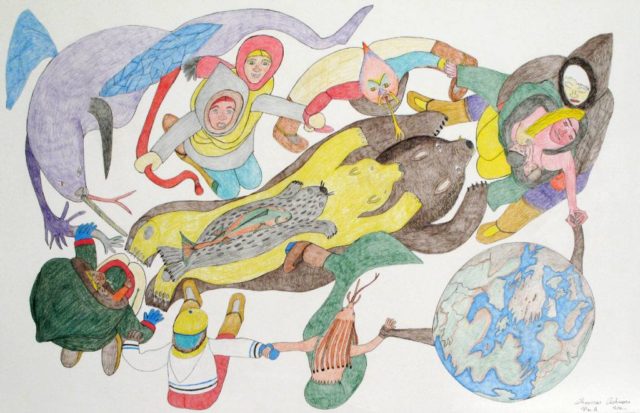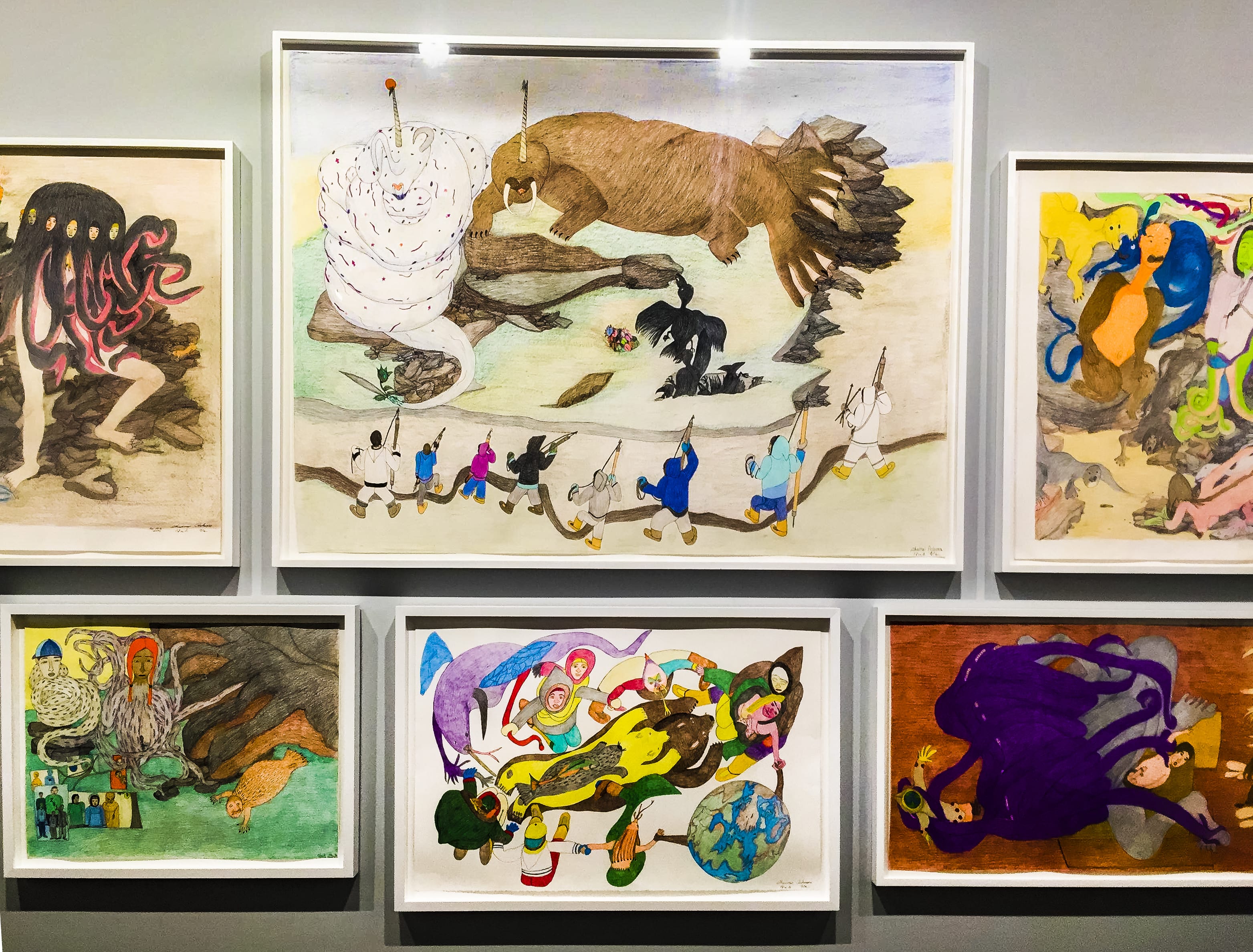Mapping Worlds presents a survey of Shuvinai Ashoona’s works over the last two decades. Ashoona (b. 1961) is an Inuk artist who primarily uses pencil and pen. This is her first major art exhibition in Quebec, making this an important moment for Inuit art in the province. The exhibition, curated by Nancy Campbell, opened with a vernissage on October 30 at Concordia’s Leonard and Bina Ellen Gallery.
Walking around the gallery space, I am deeply aware of the Earth. It is found in almost all of the artist’s works, in the unlikeliest of places: sitting in a circle, on someone’s belly, in someone’s eyes. The globes both represent the world and participate in it. In Shuvinai Ashoona’s universe, the Earth is everywhere.
Many of Ashoona’s works feature her home of Kinngait, Nunavut. However, it is a magical, absurd, and mythological vision of the world. There are humans with tentacles, monsters being hunted, and creatures invading the Arctic. Ashoona depicts worlds that are both dystopian and utopian in her art, and forces us to confront the realities of our world through her surrealist depictions of it.

Family Portrait (2014) uses ink and coloured pencil to depict what looks like a typical family photo. There is another portrait in the background – a family portrait. The shirts of the members say say things like “my last name is,” and “my name is Alee Canbell and forgive me my sun forever and forever Amen.” There is also text in Inuktitut, which creates a divide between the piece and non-Inuit people who cannot read the language. These small sentences give us a glimpse into the lives of the people Ashoona is depicting. There is something deeply intimate about this piece, with the family members embracing one another, each of them connected to another by their arms.
The exhibition also explores multiple birthing narratives. Composition (2008) illustrates the Inuit notion of Qaujimajatuqanjit: the interconnectedness of life. Different beings are holding hands in a circle, all of them participating in creation. The figure giving birth is half white, half Native, which is highlighted by her different coloured hair. The Earth is also a participant in this occasion, joining in with all of its different inhabitants for this moment.
One of the most powerful birth pieces on display is Untitled (Woman Giving Birth to the World), 2010. The woman’s stomach is a globe, and her arms are wrapped around a larger one. There are eyes with globes as irises throughout the piece, and multiple earths. The Earth depicted is not a realistic one, as this is not something Ashoona is interested in. She depicts the world as she sees it. Birthing Scene (2013) reflects another kind of birth. It shows a figure giving birth to multiple globes with a white hand at the crotch, forcing its way out. In the corner, we see a brown baby with a white baby coming out of it. The figure has webbed feet, and a bird is grabbing her hair. This scene is much more frightening than the previous one, confronting the viewer with the gruesome and violent realities of colonization and maternity.
Many of Ashoona’s pieces are simply absurd. Satan the Polar Bear shows a polar bear wearing a jacket that reads: “not brown just white WHITE white” with a human figure and two birds by its side. The heart of the bird is turning into a snake. It’s hard not to read this as a message about white colonizers and their history with the Inuit population of Nunavut and Canada as a whole.
Tentacular arms are also a heavy presence in Ashoona’s work, crawling between figures, worlds, and space. This is seen in Earth Transformations (2012), one of the only pieces drawn on black paper. The tentacles form an octopus-like creature, and the globe has feet. There is a child holding up a frame of someone who is hunting seal, presumably holding the same Kinngait landscape pictured in the first inset. The Earth has dollar bills on it, which can be read as a commentary on our current globalized capitalist systems. However, there are also many different versions of the Earth in the piece, offering us alternatives to our current world. Ashoona is allowing us to hold pluralities in our visions for our world.
Ashoona creates a powerful, surrealist image of the Arctic and invites us into her creative worlds. It is an honour to be let in.
Mapping Worlds is on view at the Leonard and Bina Ellen Gallery until January 18, 2020. Visit http://ellengallery.concordia.ca/?lang=en.

